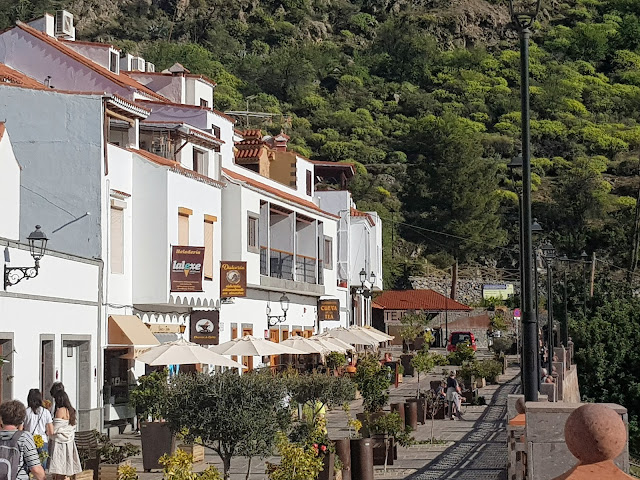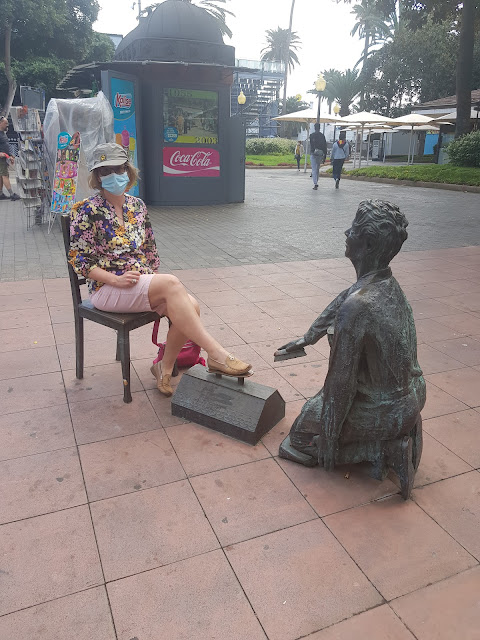Above you can see a downloaded image of part of the Angkor Wat temple complex. A visit here is a major driver for the holiday.
Friday, 30 December 2022
A Thailand Trail. The background and advance plan.
Above you can see a downloaded image of part of the Angkor Wat temple complex. A visit here is a major driver for the holiday.
Friday, 11 March 2022
Chilling out in the Canaries 11/3/2022
Round and round the rugged rock, this blog is the story of a driving trip all round the circumference of Gran Canaria. Rather than running ragged rascals, we drove our hired Renault Clio along what at times were pretty hairy roads. The road was being improved particularly in the north west quadrant. Nearly the all the west side is less developed and much more arrid as the pictures show. I'm afraid that this is going to be more of a picture gallery than a blog. This was El Risco, our first stop where we enjoyed a coffee and almond cake.
They have left some of the old road which gives access to this really remarkable viewpoint. It is called La Balcon and I don't need to explain why. In the foreground you can see ox-eyed daisies, which seem to survive anywhere. We are on the north coast here looking east towards a distant Las Palmas.
Chilling out in the Canaries 8/3/2022
Our location in Playa del Hombre means we really have to have a car in order to get the best out of this holiday. In Gran Canaria there is really only two choices. You head to the hills or you head to the beaches. Today it's the former, indeed you can't get higher than the highest peak on the island Pico de las Nieves which stands at 1,949 metres. By coincidence this happens to be the same numbers as my birth year.
Although relatively small (the circumference is 235 kms) the island displays a remarkable variety of landscapes. Ar id larval desert that only supports stubborn socially isolated cacti and the odd lizard if your eyesight is quick enough to spot that tail-flicking movement, is juxtaposed with lush verdant slopes supporting a cornucopia of agriculture. Clearly the answer lies in the microclimate. Ironically the bananas seem to be grown in those really dry areas. Presumably these are the sunniest ie cloud free districts,but more of bananas later. Let's look at some hillside farming. Terracing is of course essential with slopes like these and many are decades if not centuries old,
Seconds later the view becomes this.
And in a few more seconds..........
And if you are interested in seeing the military base, look quickly as it's a restricted area.
The next view point was also affected by cloud cover. This is the Caldera (crater) de los Marteles. It is 80 metres down to the bottom and 550 metres across. The landscape was created by an explosive phreatomagmatic eruption or for the layman when larva comes into contact with underground water. It occurred about a million years ago. The crater has a flat bottom and weather permitting you can see the geometric lines of ploughing showing that agriculture has been a traditional activity on this relatively flat land. In Wales it would have been a rugby stadium.
We continued downwards heading for a ravine type valley which has been inhabited constantly since the first indigenous peoples arrived on the island. The location represents the greatest density of archaeological sites spread along both slopes of the ravine among which troglodyte habitats abound, under escarpment ledges and on hillsides. It is considered to be one of the most stunning cultural landscapes in Gran Canaria. This troglodytic lifestyle has persisted even up to the present day.
The caves are clearly visible in the rock cliffs. As well as habitations the caves were used for storage and burial purposes. Access to many of the caves is very difficult and the remains of ancestors still remain undisturbed where they were first laid to rest many hundreds of years ago.
This historic landscape has not however remained static. It has evolved and adapted to present day living.
Meet our friend, the present day troglodyte and his humble abode. This is his washing up area which has running water..
Above is his double bed that he shared with his senhora until sadly she died of a brain haemorrhage. Now he shares a single bed, cut from the rock face, with his little dog, if you see what I mean. We moved on to another place where life has stood still.
Monday, 7 March 2022
Chilling out in the Canaries 6/3/2022
It must be five and a half years since we have seen my niece, Sarah and her now husband, Adrian. I know this because on last meeting we had discussed the outcome of that fateful day 23rd June 2016. Last week, as a matter of courtesy I phoned my brother to let him know that we would be out of the country for a couple of weeks in Gran Canaria. It was only then we learnt that Sarah and Adrian would be there at the same time. A get together in Las Palmas was called for and duly arranged. They were staying in Maspalomas whilst enjoying the rugged terrain by bike, so travelled up to Las Palmas on the bus. We, meanwhile had hired a car for the middle part of our holiday.
Actually meeting up in the city could have been quite a problem but serendipitously their bus terminal and the car park we chose were almost adjacent. Here we are with the famous Las Canteras beach behind us. This beach has over 1000 metres of fine white sand and is protected by La Barra a rock and coral barrier that not only provides excellent scuba and snorkel diving but also keeps the sea pleasantly calm.
We walked the length of the promenade taking in the sights. Wherever you go in Gran Canaria you encounter works of art, many of them bronze sculptures and each with its own story to tell. This figure (not Sarah) is dedicated to shoe cleaners the world over.
Helen arm in arm with a famous dancing teacher but I'm not sure how much she learnt.
We can't leave without reference to the importance of Las Palmas as a port. Historically Spain valued the islands as a jumping off point to the New World. Christopher Columbus discovered the advantage of the trade winds that blow east to west, north of the equator. This was why they were so keen to possess them in the late C15. Today it is still busy importing and exporting goods, as a military base and as a port of call for cruise liners. Modern day windjammers do exist and here's the living proof. A special kind of cruise can be had on the Sea Cloud Spirit. Google it up if you want more information or fancy a cruise. There were two more of a similar size nearby.


















































